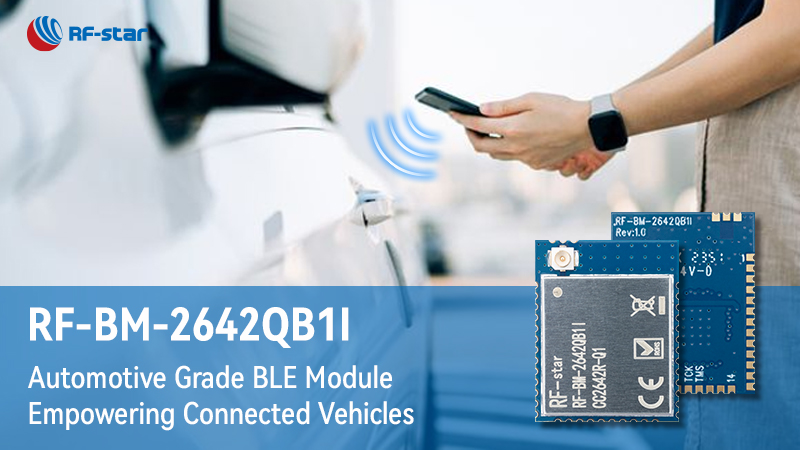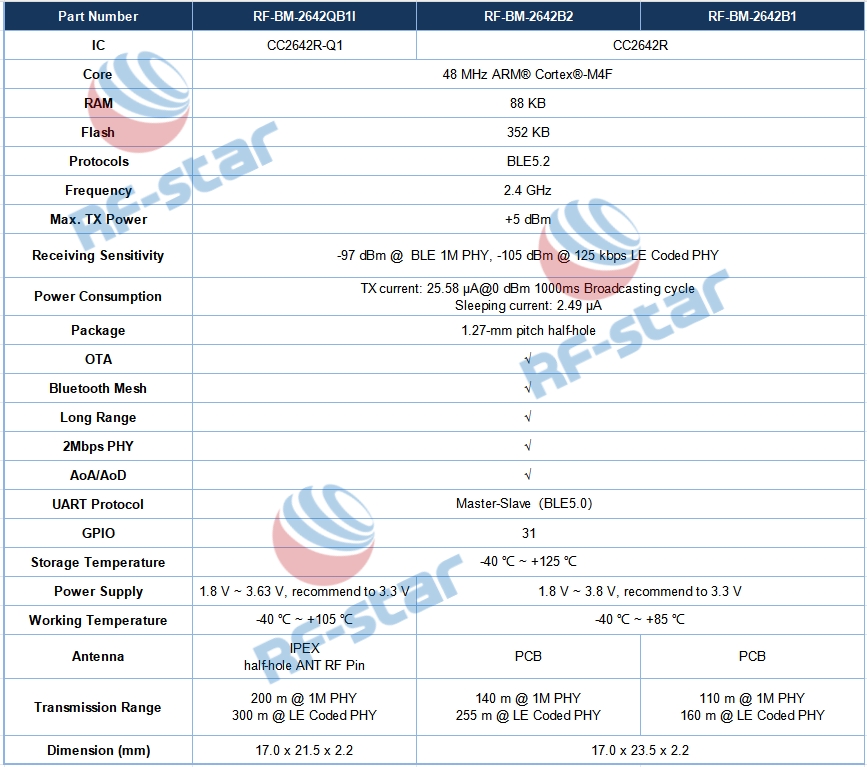CC2642R-Q1 Automotive Grade BLE Module Empowers Connected Vehicles
RF-star unveils automotive-grade Bluetooth Low Energy module RF-BM-2642QB1I based on TI CC2642R-Q1 ACE-Q100 compliant MCU. The BLE module brings enhanced security, reliability and a friendly user experience for automotive applications, including Passive Entry Passive Start (PEPS), Phone as a Key (PaaK), and Battery Management Systems (BMS).

Automotive Grade BLE Module RF-BM-2642QB1I Empowering Connected Vehicles
To meet the stringent demands of automotive environments, the RF-BM-2642QB1I module features a 48-MHz Arm® Cortex®-M4F processor with 352 KB Flash and 88 KB RAM, providing ample storage capacity for various automotive functionalities. With a wide operating temperature range from -40℃ to 105℃and compliance with AEC-Q100 automotive specifications, the CC2642R-Q1 module ensures robust performance even in challenging conditions. Here are the key highlights include but are not limited to:
Key Features of the CC2642R-Q1 Module
- Low Power Consumption: With a low standby current of 2.49uA and 25.58uA TX at 0 dBm, RF-BM-2642QB1I extends its battery life, making it ideal for power-sensitive automotive applications.
- Excellent RF Performance: Excellent radio sensitivity and robustness (selectivity and blocking) performance for Bluetooth ® Low Energy (-105 dBm for 125-kbps LE Coded PHY, -97 dBm for 1-Mbps PHY). Its TX power reaches up to + 5 dBm with temperature compensation.
- Compliant with AEC-Q100: Certified for Grade 2 temperature range (–40 °C to +105 °C), the CC2642R-Q1 module provides pre-installed vehicle applications with reliable stability and durability.
- Rich Peripherals: In addition to supporting Bluetooth® 5.2 features and earlier Low Energy specifications, the new automotive-grade module offers a variety of digital peripherals. They can route to any of 31 GPIOs, including UART, I2S, I2C, SPI, and ADC, enhancing versatility in automotive designs.
Moreover, RF-star automotive module RF-BM-2642QB1I supports Bluetooth Low Energy 5.0 serial port transmission, facilitating seamless integration with UART function for 4 working modes. It operates in master-slave mode, slave mode, master mode and beacon mode. When a device is in a master mode or master-slave mode, it supports connecting up to 7 slave devices at the same time. Its rich functions with AT commands can reduce design complexity in your development and help products quickly flow to the market.
Furthermore, the module enables over-the-air(OTA) updates for firmware deployment, streamlining the upgrade process for OEMs and end-users.
The CC2642R-Q1 module is pin-to-pin compatible with RF-star’s CC2642R series modules RF-BM-2642B1 and RF-BM-2642B2, ensuring easy integration and scalability for automotive applications. Here is a model list of CC2642R series Bluetooth LE modules to clearly show their differences.

Model list of RF-star CC2642R series modules
Its versatility extends across a wide range of use cases, including:
Car Access
Combined with the Received Signal Strength Indicator (RSSI) algorithm and CC2642R-Q1 Bluetooth nodes, the localization between the mobile phone and the vehicle can be measured accurately. So, it is well-suited for PEPS, RKE, and PaaK systems.
Battery Management Systems (BMS)
With its low power consumption and AEC-Q100 qualification, the module enhances the security, flexibility, and efficiency of BMS solutions in automotive applications.
Besides, RF-star automotive-grade module also applies to advanced driver assistance systems (ADAS), and telematics control units (TCU).
Beyond automotive use, the RF-BM-2642QB1I module finds applicability in industrial transportation, asset tracking, factory automation, and control systems, thanks to its capabilities for advertising extension, Bluetooth mesh, direction finding and long-range transmission.
Driving Innovation in IoV and IoT
In alignment with the burgeoning smart vehicle landscape, RF-star remains committed to advancing the Internet of Vehicles (IoV) industry. Over the past year, RF-star has successively become member of the Car Connectivity Consortium (CCC), and the Intelligent Car Connectivity Industry Ecosystem Alliance (ICCE), and was fortunate to draft UWB System Requirements.
“Now, its cost-effective Bluetooth Low Energy modules have been widely adopted in automotive applications, such as the BLE PEPS." Ben Qiu, GM of RF-star. "Our new wireless modules and solutions combination with UWB and BLE technologies will provide more accurate location and reliable connectivity for automotive, industrial, and other applications, further driving the innovation of IoV and IoT."
For more information about automotive-grade modules, please visit www.rfstariot.com or reach out to us at info@szrfstar.com.